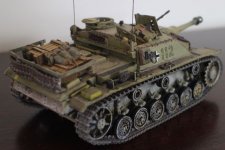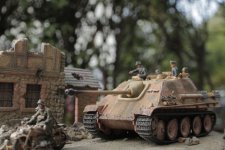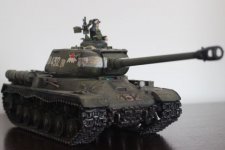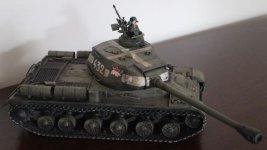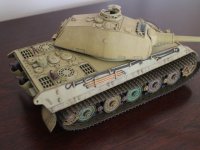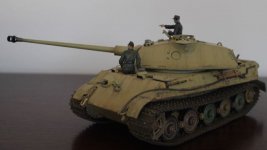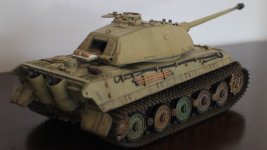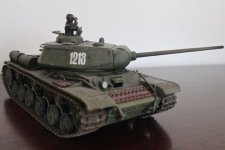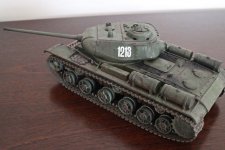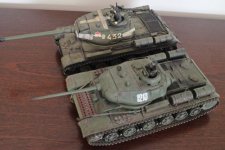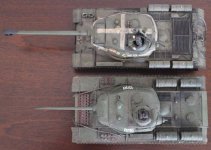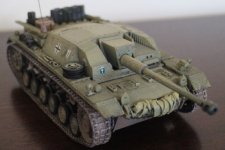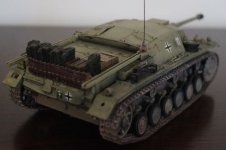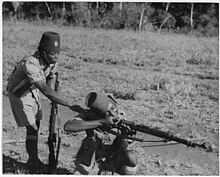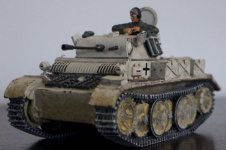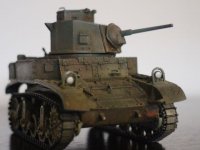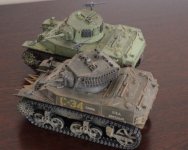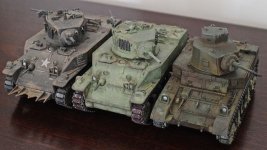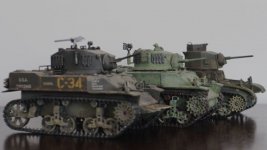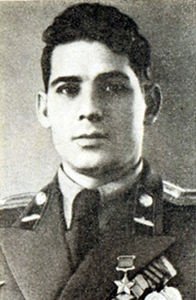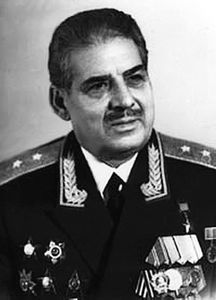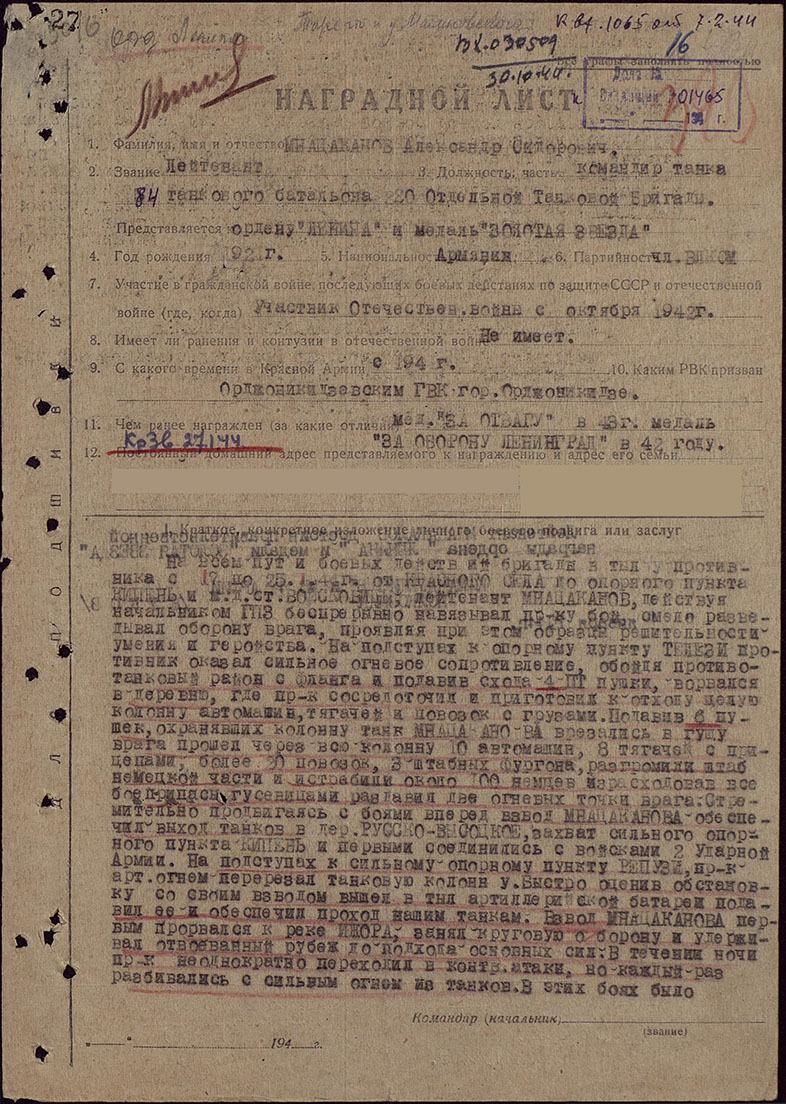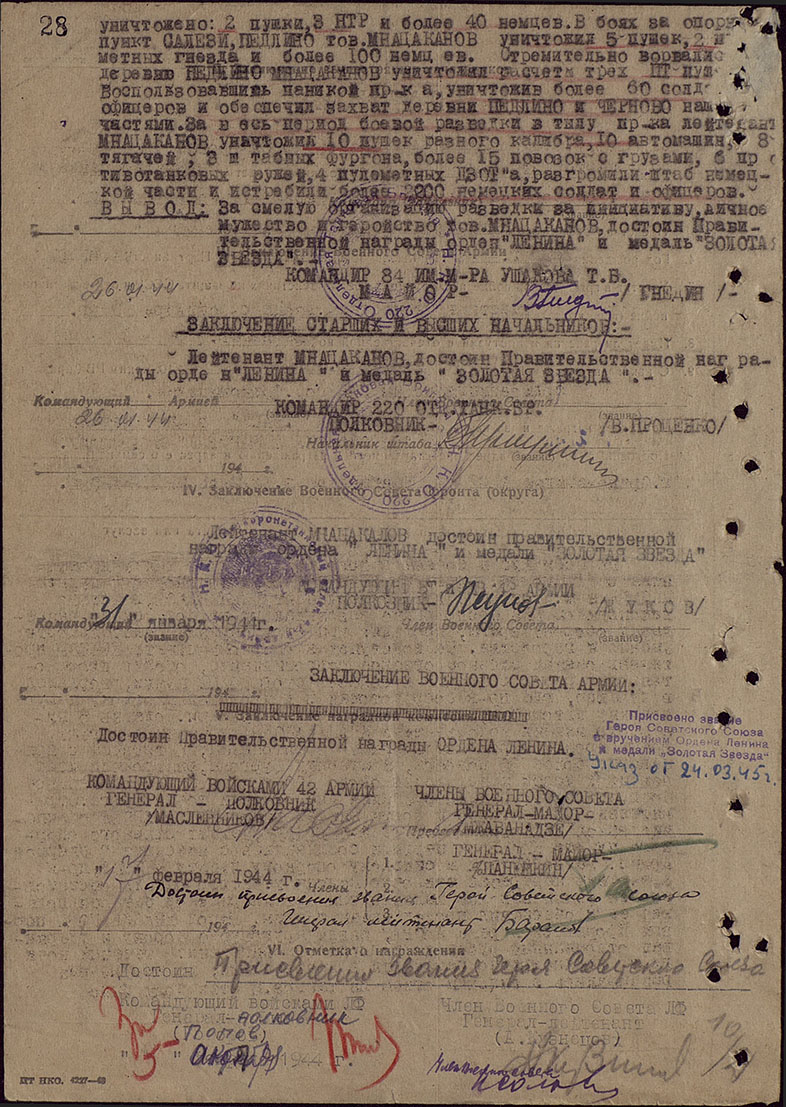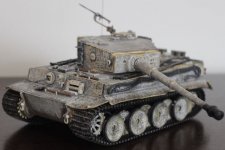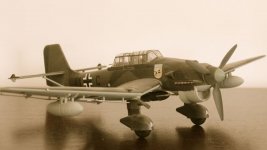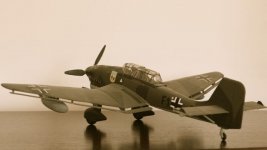tank
Specialist
- Joined
- Mar 24, 2012
- Messages
- 312
Heavy Tank IS-122 (the early modification of IS-2)
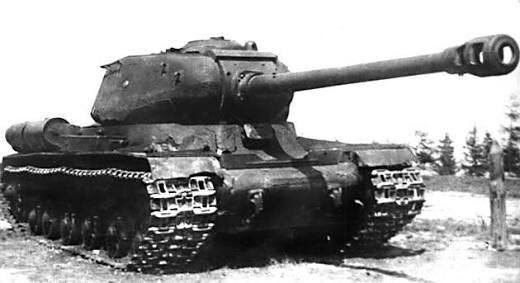
In February 1944, the breakthrough regiments of the Red Army, equipped with KV tanks, were equipped with a new IS tanks. At the same time the regiments were assigned with the name “guards”.

The new regiments totaled 375 personnel:
The four IS tank companies (21 tanks in total), a company of machine gunners, a company of technical support and an anti-aircraft battery.

The crew of the heavy IS tank had two officers in it - the tank commander and the senior driver-mechanic and two sergeants - gunner and the loader who was also the junior driver-mechanic.
The guards regiments were armed with the early modification of IS-2 (IS-122).
The IS-2 heavy tanks entered the war for the first time at the Western Ukraine.
Of the two regiments (11th and 72nd) equipped with these tanks, the 72nd OGvTTP was more successfully operated.
From April 20 to May 10, 1944 the regiment destroyed 41 Tiger tanks and self-propelled guns Ferdinand, 3 armored personnel carriers with ammunition and 10 anti-tank guns in the area of Obertin.
Durring these fights the 72nd OGvTTP irretrievably lost only 8 IS-2 tanks.

The reasons for the loss of the IS-2 tanks were as follows:
- Tank No. 40247 came under artillery fire from the self-propelled guns Ferdinand from a distance of 1,500-1,200 m on April 20 in the Gerasimuv area . The crew was able to respond with one shot only as the cannon’s trigger failed. The IS-2 received 5 hits in the frontal part of the hull that did not harm it while the tank was trying to leave the area. During this time another self-propelled gun "Ferdinand" quietly approached from the flank to a distance of 600-700 m and pierced the right side of the tank in the engine area with an armor-piercing projectile. The crew left a stopped the tank, which soon caught fire;
- tank number 40255 received a direct hit of the 88-mm shell from the Tiger tank in the lower front inclined armor plate from a distance of 1000-1100m. As a result of which the left fuel tank was pierced, the driver was wounded by armor fragments, and the rest of the crew got light burns. The tank burned down
- tank No. 4032, after having withstood three hits from the Tiger tank into the hull from a distance of 1,500-1,000 m it was destroyed by the fire of another Tiger from a distance of 500-400 m. An 88-mm armor-piercing projectile pierced the lower right frontal leaf, ignited of the gunpowder of the shell, and the tank burned down. The tankers, left the IS-2, the wounded senior driver-mechanic was taken by crew to hospital.
- tank No. 4033, after receiving a shell from a Tiger from a distance of 400 m in the lower armored plate of the hull, was towed to the assembly point of damaged vehicles (SPMP) for major repairs;
- tank No. 40260 burned down after it was hitting by the 88-mm shell from a Tiger tank from the left side from a distance of 500 m. The shell destroyed the engine and the tank caught fire.
The tank commander and gunner were injured;
- Tank No. 40244 received a direct hit by an armor-piercing shell from a Tiger tank from a distance of 800-1000 m to the starboard side of the hull. The senior driver-mechanic was killed, and the diesel fuel was spilling from the destroyed right fuel tank and ignited inside the tank. The tank was evacuated and then blown up by sappers;
- tank number 40263 burned down when two shells hit at the IS-2 side;
-tank number 40273 operated in isolation from the regiment. On April 30, near the village of Igzhiska the IS-2 participated in repelling of the attack of 50 T-III, T-IV, and T-VI tanks. The IS-2 received two direct hits: the first - in the turret and immediately after that the second shell - in the area of the engine compartment. The crew in the turret was killed and the senior driver-mechanic was wounded. The tank was left on enemy territory;
- tank number 40254 was hit by the armor-piercing projectile of the self-propelled gun “Ferdinand”.
The self-propelled gun “Ferdinand” was in ambush. The first shell did not penetrate the turret but the second shell pierced the side of the tank hull and disabled the engine. The crew was evacuated, and the IS-2 burned down;
- tank number 40261 received a direct hit in the barrel of the gun. After the battle, the barrel was replaced with a new one later the tank was put into overhaul.
The remaining five heavy tanks IS-2 disabled during the fighting, were restored by the company of technical support of the regiment.

In August 1944, the 71st OGvTPP, equipped with IS-122 tanks of the first release together with the tankers of the 6th Guards Tank Corps, participated in the defeat of the Royal Tigers battalion at the Sandomierz bridgehead.
The “Report on the fighting of the regiment from 07/14/44 to 08/31/44":
“In the morning of August 13, 2004, the 71st OGvTTP regiment, in cooperation with the 289th infantry regiment of the 97th infantry division, launched an offensive in the direction of Oglenduv.
The “Royal Tiger” tanks on the outskirts of Oglenduv blocked the path of the advancing infantry with their fire. The platoon of the IS-122 tanks of the guard senior lieutenant Klimenkov moved forward and opened fire on the “Royal Tigers” . As a result of a short battle the IS-122 Klimenkov burned one “Royal Tiger” and knocked out the second (these were the first destroyed the “Royal Tiger” Tanks).

The infantry not meeting a strong resistance burst into Oglenduv. At the same time 7 “Royal Tigers” attacked our positions from the height 272.1.
The tank of the guard senior lieutenant Udalov was in ambush on the east of Mokre. He let the enemy’s tanks come to 700-800 m and than his IS-122 opened fire on the “Royal Tigers” . With several well-aimed shots the tanks of the guard senior lieutenant Udalov burned one “Royal Tiger” and knocked out the second. When the enemy’s tanks passed the ambush position the IS-122 of the guard senior lieutenant Udalov left his ambush position and moved through a forest towards the enemy. The IS-122 opened fire again from the edge of the forest.
Leaving behind an another burning “Royal Tiger” the Germans retreated.
Soon the attack of the “Royal Tigers” was repeated but this time they went in the direction to Ponik, where the IS-122 of the guard of lieutenant Belyakov was standing in ambush.
The guard of lieutenant Belyakov opened fire from a distance of 1000 m. He knocked down the leading with the third shell and forced the others ‘Royal Tigers” to turn back.
During the day the tankers of the 71st OGvTTP regiment together with an artillery, repulsed 7 enemy tank attacks. They inflicted to Nazis a heavy losses in equipment and manpower.

Experience has shown:
The marching capabilities of the IS-122 tanks - up to 70-100 km per day at an average speed. The speed on the highway 20-25 km / h and the off-road speed - 10-15 km / h. Cruising range - 125-150 km. On average the IS-122 tanks traveled 1,100 km.
Tanks engines worked 270 motor / hours instead of the instruction guarantee 150 m / h. Practical speed on the battlefield in rough terrain reaches 8-12 km / h. The practical rate of fire from the gun is 2-3 rds / min.
The shooting and observation conditions from the tank are generally satisfactory...
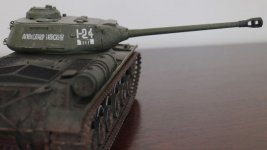
IS-2 (Object 240)

In February 1944, the breakthrough regiments of the Red Army, equipped with KV tanks, were equipped with a new IS tanks. At the same time the regiments were assigned with the name “guards”.

The new regiments totaled 375 personnel:
The four IS tank companies (21 tanks in total), a company of machine gunners, a company of technical support and an anti-aircraft battery.
The crew of the heavy IS tank had two officers in it - the tank commander and the senior driver-mechanic and two sergeants - gunner and the loader who was also the junior driver-mechanic.
The guards regiments were armed with the early modification of IS-2 (IS-122).
The IS-2 heavy tanks entered the war for the first time at the Western Ukraine.
Of the two regiments (11th and 72nd) equipped with these tanks, the 72nd OGvTTP was more successfully operated.
From April 20 to May 10, 1944 the regiment destroyed 41 Tiger tanks and self-propelled guns Ferdinand, 3 armored personnel carriers with ammunition and 10 anti-tank guns in the area of Obertin.
Durring these fights the 72nd OGvTTP irretrievably lost only 8 IS-2 tanks.
The reasons for the loss of the IS-2 tanks were as follows:
- Tank No. 40247 came under artillery fire from the self-propelled guns Ferdinand from a distance of 1,500-1,200 m on April 20 in the Gerasimuv area . The crew was able to respond with one shot only as the cannon’s trigger failed. The IS-2 received 5 hits in the frontal part of the hull that did not harm it while the tank was trying to leave the area. During this time another self-propelled gun "Ferdinand" quietly approached from the flank to a distance of 600-700 m and pierced the right side of the tank in the engine area with an armor-piercing projectile. The crew left a stopped the tank, which soon caught fire;
- tank number 40255 received a direct hit of the 88-mm shell from the Tiger tank in the lower front inclined armor plate from a distance of 1000-1100m. As a result of which the left fuel tank was pierced, the driver was wounded by armor fragments, and the rest of the crew got light burns. The tank burned down
- tank No. 4032, after having withstood three hits from the Tiger tank into the hull from a distance of 1,500-1,000 m it was destroyed by the fire of another Tiger from a distance of 500-400 m. An 88-mm armor-piercing projectile pierced the lower right frontal leaf, ignited of the gunpowder of the shell, and the tank burned down. The tankers, left the IS-2, the wounded senior driver-mechanic was taken by crew to hospital.
- tank No. 4033, after receiving a shell from a Tiger from a distance of 400 m in the lower armored plate of the hull, was towed to the assembly point of damaged vehicles (SPMP) for major repairs;
- tank No. 40260 burned down after it was hitting by the 88-mm shell from a Tiger tank from the left side from a distance of 500 m. The shell destroyed the engine and the tank caught fire.
The tank commander and gunner were injured;
- Tank No. 40244 received a direct hit by an armor-piercing shell from a Tiger tank from a distance of 800-1000 m to the starboard side of the hull. The senior driver-mechanic was killed, and the diesel fuel was spilling from the destroyed right fuel tank and ignited inside the tank. The tank was evacuated and then blown up by sappers;
- tank number 40263 burned down when two shells hit at the IS-2 side;
-tank number 40273 operated in isolation from the regiment. On April 30, near the village of Igzhiska the IS-2 participated in repelling of the attack of 50 T-III, T-IV, and T-VI tanks. The IS-2 received two direct hits: the first - in the turret and immediately after that the second shell - in the area of the engine compartment. The crew in the turret was killed and the senior driver-mechanic was wounded. The tank was left on enemy territory;
- tank number 40254 was hit by the armor-piercing projectile of the self-propelled gun “Ferdinand”.
The self-propelled gun “Ferdinand” was in ambush. The first shell did not penetrate the turret but the second shell pierced the side of the tank hull and disabled the engine. The crew was evacuated, and the IS-2 burned down;
- tank number 40261 received a direct hit in the barrel of the gun. After the battle, the barrel was replaced with a new one later the tank was put into overhaul.
The remaining five heavy tanks IS-2 disabled during the fighting, were restored by the company of technical support of the regiment.
In August 1944, the 71st OGvTPP, equipped with IS-122 tanks of the first release together with the tankers of the 6th Guards Tank Corps, participated in the defeat of the Royal Tigers battalion at the Sandomierz bridgehead.
The “Report on the fighting of the regiment from 07/14/44 to 08/31/44":
“In the morning of August 13, 2004, the 71st OGvTTP regiment, in cooperation with the 289th infantry regiment of the 97th infantry division, launched an offensive in the direction of Oglenduv.
The “Royal Tiger” tanks on the outskirts of Oglenduv blocked the path of the advancing infantry with their fire. The platoon of the IS-122 tanks of the guard senior lieutenant Klimenkov moved forward and opened fire on the “Royal Tigers” . As a result of a short battle the IS-122 Klimenkov burned one “Royal Tiger” and knocked out the second (these were the first destroyed the “Royal Tiger” Tanks).
The infantry not meeting a strong resistance burst into Oglenduv. At the same time 7 “Royal Tigers” attacked our positions from the height 272.1.
The tank of the guard senior lieutenant Udalov was in ambush on the east of Mokre. He let the enemy’s tanks come to 700-800 m and than his IS-122 opened fire on the “Royal Tigers” . With several well-aimed shots the tanks of the guard senior lieutenant Udalov burned one “Royal Tiger” and knocked out the second. When the enemy’s tanks passed the ambush position the IS-122 of the guard senior lieutenant Udalov left his ambush position and moved through a forest towards the enemy. The IS-122 opened fire again from the edge of the forest.
Leaving behind an another burning “Royal Tiger” the Germans retreated.
Soon the attack of the “Royal Tigers” was repeated but this time they went in the direction to Ponik, where the IS-122 of the guard of lieutenant Belyakov was standing in ambush.
The guard of lieutenant Belyakov opened fire from a distance of 1000 m. He knocked down the leading with the third shell and forced the others ‘Royal Tigers” to turn back.
During the day the tankers of the 71st OGvTTP regiment together with an artillery, repulsed 7 enemy tank attacks. They inflicted to Nazis a heavy losses in equipment and manpower.
Experience has shown:
The marching capabilities of the IS-122 tanks - up to 70-100 km per day at an average speed. The speed on the highway 20-25 km / h and the off-road speed - 10-15 km / h. Cruising range - 125-150 km. On average the IS-122 tanks traveled 1,100 km.
Tanks engines worked 270 motor / hours instead of the instruction guarantee 150 m / h. Practical speed on the battlefield in rough terrain reaches 8-12 km / h. The practical rate of fire from the gun is 2-3 rds / min.
The shooting and observation conditions from the tank are generally satisfactory...

IS-2 (Object 240)










